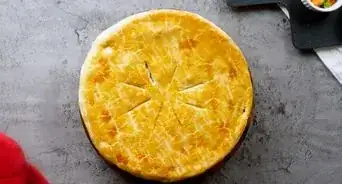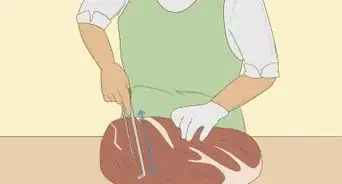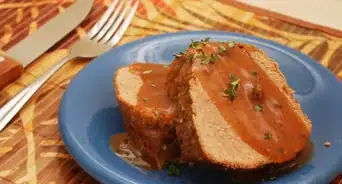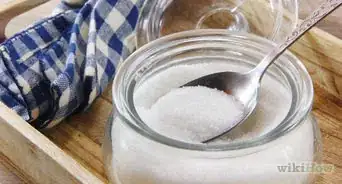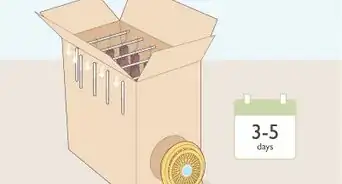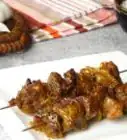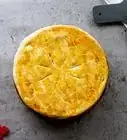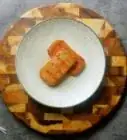This article was co-authored by wikiHow staff writer, Jessica Gibson. Jessica Gibson is a Writer and Editor who's been with wikiHow since 2014. After completing a year of art studies at the Emily Carr University in Vancouver, she graduated from Columbia College with a BA in History. Jessica also completed an MA in History from The University of Oregon in 2013.
There are 9 references cited in this article, which can be found at the bottom of the page.
The wikiHow Culinary Team also followed the article's instructions and verified that they work.
This article has been viewed 23,340 times.
Learn more...
Even the best lamb chops might need a little trimming when you bring them home from the butcher's. In most cases, you just need to cut away visible fat. However, for a more ambitious project, you can buy an entire rack of lamb and trim it yourself. Cleaning the bones of fat is called Frenching and this simple process gives your rack of lamb a professional, polished look.
Steps
Chops
-
1Lay the rack flat and slice in between each bone to make rib chops. Cutting custom chops is as easy as slicing through a rack! Place a trimmed rack of lamb flat on a cutting board and use your boning knife to cut through the meat in between each bone to make individual chops. If you want a double rib chop, just cut between every 2 bones instead of between every single bone.[1]
- Rib chops are one of the most popular lamb cuts for a reason—they're like a ribeye steak that has a bit of belly meat at the base of the bone.
-
2Cut away fat from the sides of a rib, loin, or shoulder chop. It's always a good idea to trim any type of lamb chop you bring home. Just take a sharp knife and cut off the opaque white fat that you see on the sides of your lamb chops. Try to cut off as much fat as you can, but be careful not to trim off flavorful meat.[2]
- Looking for lean chops that don't have a lot of fat? Pick up loin chops! These are boneless and lean, so there's not much fat to trim.
Advertisement -
3Set the chops at room temperature for 1 hour before you cook them. It's easy to overcook lamb chops if you start cooking them straight out of the fridge. To ensure a golden-brown crust and tender interior, bring the meat to room temperature for an hour. Then, you can grill, roast, or slow cook them.[3]
- If you're not ready to use the lamb right away, refrigerate the chops in an airtight container for up to 5 days.
Rack of Lamb
-
1Cut straight across the fat of the rack. To get a good idea of where to cut, lay a rack of lamb flat on a cutting board with the fat side facing up. Take a sharp boning knife and cut through this fat down to the bone from 1 end of the rack to the other. This makes a guideline that you'll use to cut between the rib bones.[4]
- Slice about 2 to 3 inches (5.1 to 7.6 cm) from the rib eye meat.
- It's really important to use a sharp boning knife that you're comfortable with handling.
-
2Slide the knife horizontally in between each rib bone. There's a lot of fat to remove from the rack, so set the rack vertically and hold the rib bones with 1 hand. Then, put your knife through the guideline you just cut and push until it comes out through the other side of the rack. Wiggle the knife from side to side so you mark the other side of the rack. Do this in between each rib bone across the rack.[5]
- Be really careful as you do this and don't let the rack slide as you work.
-
3Score the membrane on each rib bone. Lay the rack down so you can see the ribs with the thin, white membrane. Since the membrane is really tough when you cook it, take your knife and cut along each bone so you slice the membrane. This makes it easier to remove.[6]
- Membrane is tough, so don't be afraid to push hard with your knife so it scrapes into the bone.
-
4Pull the fat and membrane back and away from the rib bones. Now it's time to get rid of the fat and membrane that's covering the rib bones. Flip the rack over and bend the fat and membrane away from the ribs. It takes some strength, so pull hard and the fat and membrane will come off.[7]
- Having trouble pulling the fat and membrane off? No worries! Use your knife to cut through the membrane that you can't pull.
-
5Scrape the sides of each rib bone to get rid of anything that's sticking to them. You're almost done trimming the rack! You might see bits of meat or fat clinging to the sides of the rib bones. Cut these away and pull them off if they're large enough. For little bits, use the back of your knife to scrape back and forth along the sides of the bones.[8]
- Don't use the sharp edge of your knife to scrape the bones or you'll dull the blade really fast.
-
6Rub a clean towel over each bone to wipe them clean. To get the bones looking neat and polished, take a clean kitchen cloth or paper towel and wipe it around each bone. This just removes the tiniest bits of meat or fat off of the exposed bones.[9]
- If your rack has a few short bones near the base of the meat, cut the strip of bones away so you'll be able to cut the rack later.
-
7Cut off the fat cap that's covering the rack. Now that you've got the exposed bones looking great, it's time to focus on the meat. Lay the rack flat with the fat side facing up and start to pull it back with your hand. Then, use your knife to cut away the thick layer of fat that's covering the tender meat. If you see a shimmery thin layer of silverskin, pull that off as well.[10]
- Silverskin is connective tissue that becomes tough and chewy when you cook it. This is why it's important to trim off any that you see.
- Rack of lamb is great to toss on the grill or roast in the oven.
Warnings
- It's really easy to cut yourself when handling raw meat, so be careful when you're using a knife.⧼thumbs_response⧽
Things You'll Need
- Boning knife
- Cutting board
- Kitchen towel or cloth
References
- ↑ https://www.saveur.com/lamb-chop-guide/
- ↑ https://www.trylamb.ie/blog-1/how-to-trim-fat-when-cooking-lamb
- ↑ https://youtu.be/l20NB8IPqa8?t=16
- ↑ https://youtu.be/O7ZKGe_CxAM?t=50
- ↑ https://www.simplyrecipes.com/recipes/how_to_french_a_rack_of_lamb/
- ↑ https://youtu.be/O7ZKGe_CxAM?t=139
- ↑ https://youtu.be/O7ZKGe_CxAM?t=174
- ↑ https://www.seriouseats.com/2010/04/how-to-clean-and-french-a-lamb-rack.html
- ↑ https://www.simplyrecipes.com/recipes/how_to_french_a_rack_of_lamb/


